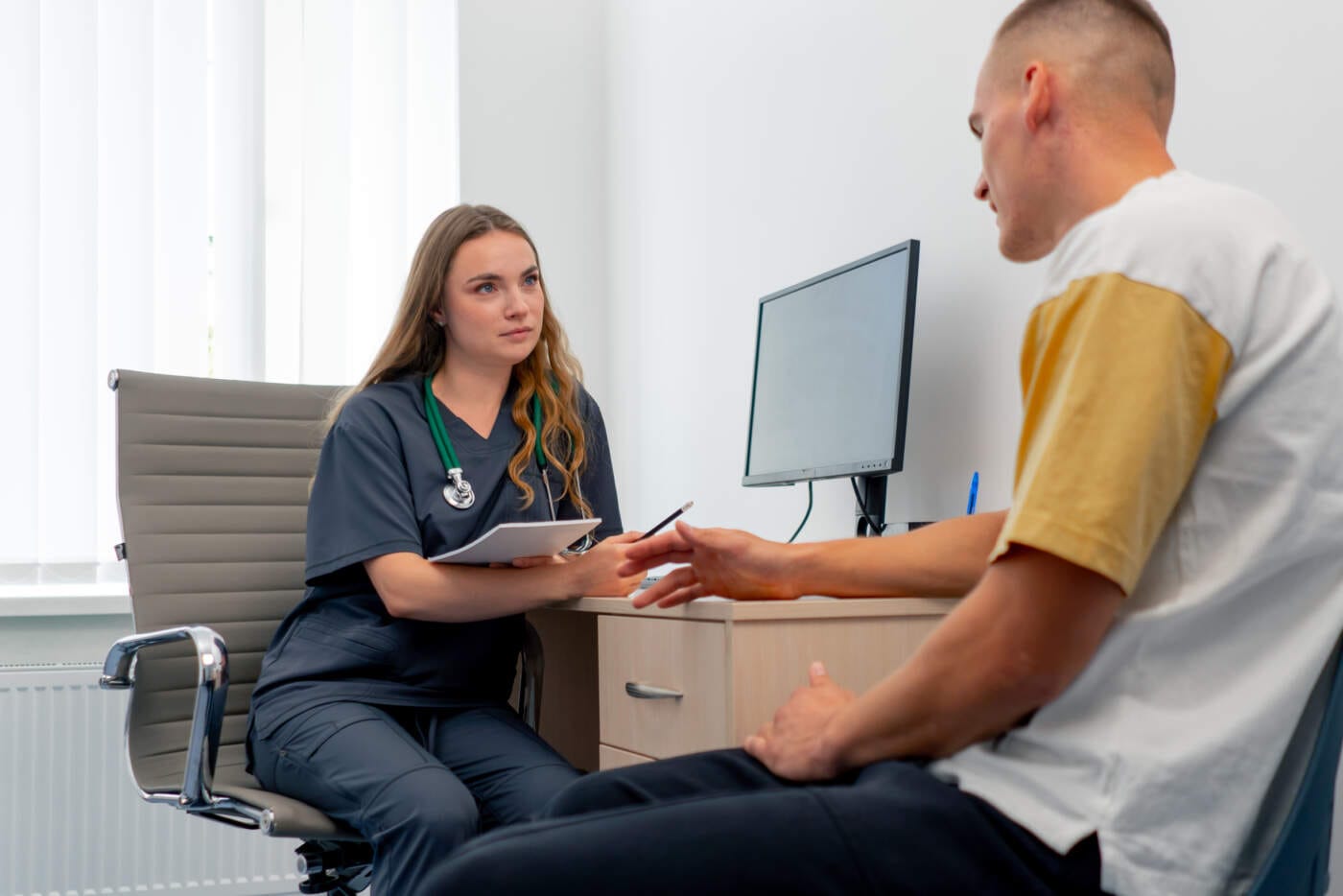Hearing the words “You have diabetes” can feel like the ground shifting beneath your feet. Suddenly, there’s a rush of questions, worries, maybe even fear or anger. You might feel overwhelmed, confused, or perhaps strangely relieved to finally have an answer for symptoms you’ve been experiencing.
Take a deep breath.
Seriously, pause for a moment and just breathe. It’s completely normal to feel a whirlwind of emotions right now. Receiving a diabetes diagnosis is significant news, and it marks the beginning of a new chapter in your life. But here’s the most important thing to remember right now: You are not alone, and you can manage this.
As someone who writes often about diabetes and understands the journey many people face, my goal here is to offer a compassionate guide for your very first steps. Think of this as a friendly, reassuring hand to hold as you navigate these initial days and weeks. We’ll break down what to expect and what actions you can take, turning that feeling of overwhelm into a sense of empowerment.
First Things First: Acknowledge Your Feelings
Before diving into action plans, allow yourself space to process the diagnosis. Denial, anger, sadness, frustration, anxiety – these are all common and valid reactions. Maybe you feel guilty or blame yourself, especially if diagnosed with Type 2 diabetes. Please be kind to yourself. Diabetes is complex; it’s influenced by genetics, environment, lifestyle, and sometimes factors we don’t fully understand. This diagnosis is not a personal failing.
Talk to someone you trust – a partner, family member, or close friend. Sometimes just saying the words “I’ve been diagnosed with diabetes” out loud can help you begin to accept it. Remember, acknowledging your feelings is the first step towards managing them constructively.
Understanding Your Specific Diagnosis (The Basics)
Your doctor likely told you whether you have Type 1 diabetes, Type 2 diabetes, or perhaps another form like LADA (Latent Autoimmune Diabetes in Adults) or Gestational Diabetes (diagnosed during pregnancy). While all involve issues with blood sugar (glucose) and insulin, the underlying causes and initial treatments differ:
- Type 1 Diabetes: Your body’s immune system has mistakenly attacked and destroyed the insulin-producing beta cells in your pancreas. You will need to take insulin (via injections or an insulin pump) from the start to survive, as your body makes very little or none. This often appears more suddenly.
- Type 2 Diabetes: Your body either doesn’t produce enough insulin, or your cells have become resistant to the insulin that is produced (insulin resistance). This is more common and often develops gradually. Initial management might involve lifestyle changes (diet, exercise) and oral medications (like Metformin), though some people may need insulin later on, or even from the start depending on blood sugar levels.
- LADA: Often called “Type 1.5,” it’s an autoimmune form like Type 1 but develops much more slowly, often initially misdiagnosed as Type 2. Insulin therapy is typically needed eventually.
It’s crucial to understand your specific type, as it dictates your treatment plan. Don’t hesitate to ask your doctor clarifying questions if you’re unsure.
Building Your Diabetes Care Team: You’re the Captain!
Managing diabetes is rarely a solo effort. Think of yourself as the captain of a ship, and you need a skilled crew. Your core team will likely include:
- Primary Care Physician (PCP) or General Practitioner (GP): Your main doctor who likely diagnosed you or will oversee your general health.
- Endocrinologist (Optional but Recommended): A specialist in hormone disorders, including diabetes. They have deep expertise in managing blood sugar, medications, and potential complications. Especially crucial for Type 1 diabetes, complex Type 2, or if you’re struggling to meet goals.
- Registered Dietitian (RD) or Nutritionist: Preferably one specializing in diabetes (look for CDCES credential – see below). They are vital for helping you understand how food affects your blood sugar and creating a sustainable, enjoyable eating plan. This is NOT about restrictive dieting; it’s about balanced nutrition.
- Certified Diabetes Care and Education Specialist (CDCES) / Certified Diabetes Educator (CDE): These professionals (often nurses, dietitians, or pharmacists) are specifically trained to provide comprehensive diabetes education and support – from using monitors and medications to coping strategies. Ask your doctor for a referral!
- Eye Doctor (Ophthalmologist or Optometrist): Regular dilated eye exams are essential to check for diabetic retinopathy, a potential complication. Get a baseline exam soon after diagnosis.
- Podiatrist (Foot Doctor): Diabetes can affect circulation and nerve function in your feet. A podiatrist can check for issues and teach you proper foot care.
- Dentist: Gum disease can be more common and affect blood sugar control. Regular dental check-ups are important.
- Mental Health Professional (Therapist, Counselor, Psychologist): Managing a chronic condition can be stressful and impact mental well-being. Having support for the emotional side is incredibly valuable.
Don’t feel pressured to assemble everyone overnight! Start with your PCP and ask for referrals, particularly to an RD/CDCES and potentially an endocrinologist.
Your First Medical Steps & Key Numbers
After the initial diagnosis, expect some follow-up actions:
- Follow-Up Appointments: Schedule the appointments recommended by your doctor. Bring a list of questions!
- Blood Tests: Your doctor likely performed tests like:
- A1C (or HbA1c): Measures your average blood sugar level over the past 2-3 months. It gives a bigger picture than a single reading. Your doctor will set a target A1C goal for you.
- Fasting Plasma Glucose (FPG): Measures blood sugar after an overnight fast.
- Random Plasma Glucose: Measures blood sugar at any time.
- Possibly: Tests for antibodies (if Type 1 or LADA is suspected) or kidney function tests.
- Prescriptions: Your doctor might prescribe:
- Oral Medications: Metformin is a very common first-line drug for Type 2 diabetes. Others exist that work in different ways.
- Insulin: Essential for Type 1, sometimes needed for Type 2 (either initially or later). Your team will teach you how to inject it or use a pump.
- Other Injectables: Some non-insulin injectable medications help manage blood sugar, primarily for Type 2.
- Blood Glucose Monitoring: You’ll likely need to start checking your blood sugar levels at home. This is crucial data!
- Blood Glucose Meter (BGM): Requires a finger prick to get a small drop of blood onto a test strip inserted into the meter. Your team will teach you how and when to test.
- Continuous Glucose Monitor (CGM): A sensor inserted under the skin measures glucose in the interstitial fluid continuously, sending readings to a receiver or smartphone. This provides much more data, including trends. Discuss with your doctor if this is an option for you.
Learning to Monitor Your Blood Sugar: Your Personal Dashboard
Checking your blood sugar might seem daunting, but think of it as looking at your car’s dashboard – it tells you what’s happening and if you need to adjust anything (like taking medication, eating, or waiting to exercise). It helps you understand how food, activity, stress, and medication affect your body. Keep a log (notebook or app) initially – it’s invaluable information for you and your care team. Don’t judge the numbers; just observe and learn.
Embracing Lifestyle Adjustments (It’s Not About Perfection)
Lifestyle plays a significant role, especially in Type 2 diabetes management (though it’s important for Type 1 too!). Approach these changes gradually and with self-compassion.
- Nutrition – Fueling Your Body Wisely:
- Focus on Balance, Not Deprivation: Forget crash diets. Aim for balanced meals with lean protein, healthy fats, non-starchy vegetables, and controlled portions of carbohydrates (fruits, starchy veggies, grains).
- Understand Carbohydrates: Carbs break down into glucose, impacting blood sugar most directly. Learning about carb counting or consistent carbohydrate intake can be very helpful. An RD/CDCES is your best guide here.
- Read Labels: Pay attention to serving sizes and carbohydrate counts.
- Stay Hydrated: Water is your best friend!
- Work with a Professional: Seriously, seeing an RD/CDCES is one of the best investments you can make. They’ll personalize a plan that works for you, your preferences, and your lifestyle.
- Physical Activity – Getting Moving:
- Find Something You Enjoy: Walking, swimming, dancing, chair exercises – anything that gets you moving counts!
- Start Small: Aim for 10-15 minutes most days and gradually increase as you feel comfortable. The general goal is often 150 minutes of moderate-intensity activity per week.
- Check Blood Sugar: Understand how exercise affects your levels (it usually lowers them, but not always). Discuss timing with your doctor, especially if you take insulin.
- Benefits Galore: Exercise improves insulin sensitivity, helps manage weight, boosts mood, and reduces cardiovascular risk.
- Stress Management & Sleep:
- Stress Matters: Stress hormones can raise blood sugar levels. Find healthy coping mechanisms: deep breathing, meditation, yoga, hobbies, spending time in nature.
- Prioritize Sleep: Poor sleep can negatively impact blood sugar control and overall health. Aim for 7-9 hours per night.
What to Expect on This Journey: It’s a Marathon, Not a Sprint
- Information Overload: You’ll be learning a lot initially. Don’t expect to grasp everything at once. Take notes, ask questions repeatedly if needed, and focus on one or two changes at a time.
- Ups and Downs: Blood sugar levels fluctuate. You’ll have days with perfect numbers and days that are frustratingly high or low for no apparent reason. This is normal. Focus on trends, not single readings.
- Adjustments: Your treatment plan might need tweaking over time as your body changes or your lifestyle evolves. Regular check-ins with your team are key.
- Feeling Different: You might feel more tired initially as your body adjusts to medication or more stable blood sugar levels. Be patient.
- It Gets Easier: The routines of checking blood sugar, taking medication, and making mindful food choices will become second nature over time.
Finding Your Support System: You Don’t Have to Do This Alone
Connecting with others who understand can make a huge difference:
- Lean on Your Care Team: They are your primary resource.
- Family and Friends: Educate them gently about your needs and how they can support you (e.g., understanding food choices, being patient).
- Diabetes Education Programs: Often offered through hospitals or clinics. Highly recommended!
- Support Groups: Online forums (like those from the American Diabetes Association, JDRF, Beyond Type 1/Beyond Type 2) or local meetups can provide invaluable peer support and practical tips. Hearing from others on the same path reduces feelings of isolation.
Taking the Reins: A Diagnosis Doesn’t Define You
Yes, a diabetes diagnosis means making changes. It requires attention and effort. But it absolutely does not mean your life is over or that you can’t enjoy the things you love.
Think of this as gaining new knowledge and tools to take better care of your amazing body. By understanding your diabetes, working with your healthcare team, making gradual lifestyle adjustments, and seeking support, you can manage this condition effectively and live a full, vibrant, and healthy life. You are still you. This is just one part of your story, and you are the one holding the pen.
Take it one step, one day, one blood sugar check at a time. You’ve got this.
Disclaimer: This blog post is intended for informational purposes only and does not constitute medical advice. The information provided is not a substitute for professional medical advice, diagnosis, or treatment from your qualified healthcare provider. Always seek the advice of your physician or other qualified health professional with any questions you may have regarding your specific medical condition and treatment plan.












Leave a Comment